|
|
|
|
|
|
|
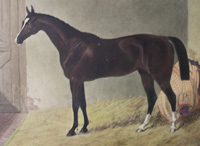
Orlando
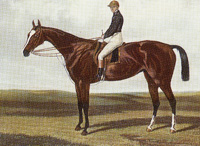
Courtesy of Fores Gallery

Sire Line

Touchstone

Camel

|
Orlando b c 1841 (Touchstone -
Vulture, by Langar). Sire Line Camel.
Family 13-a.
He was bred and raced by Colonel
(later Major-General) Jonathan Peel (1799-1879), younger brother of
Prime Minister Sir Robert Peel, who also bred the Two Thousand Guineas
Stakes winner Archibald (b c 1829 Paulowitz). His
dam, Vulture (ch f 1833), bred by Mr Allanson and sold to Colonel Peel
in in 1836, was described as "the speediest animal of her day," and once
beat Grey Momus (gr c 1835
Comus) for a £1000 match whilst giving
him nearly 40 pounds. She was a half sister to Lady Moore Carew (b f
1830 Tramp) and Lancashire Witch (ch f 1842 Tomboy), to both of whom
trace successful and durable branches of
Family 13-a, the latter's
descendants in Australia and New Zealand.
A "singularly elegant and handsome
horse," he stood over 15 hands 2 inches with a white face and white hind
stockings. Said to be finely knit with strong quarters he was thought
"rather wide in the chest and too thick in the shoulder," which faults
were said to be "characteristic of the Touchstones". He won almost every
race he entered including the Derby Stakes which he was awarded on the
disqualification of the four year old Running Rein.
Purchased after his turf career by
Mr Charles Greville, he covered initially at Barrow's Stud Paddocks at
Newmarket and at Bonehill Farm, near Tamworth, then later moved to
Hampton Court. His stock were said to possess great substance, with
splendid action and symmetry and inclined to be "a
little gaudy, with tapering heads and a tendency to white." In the stud
he got the Derby winner
Teddington (ch c 1848) and the Two Thousand Guineas winners Fazzoletto
(b c 1853), Fitz-Roland (ch c 1855) and Diophantus (ch c 1858). His St.
Leger winner, Imperieuse (b f 1854), also won the One Thousand Guineas
Stakes. He was a Champion Sire in 1851, 1854 and 1858.
Orlando died at Hampton Court in
December of 1868.
|
Orlando |
Touchstone |
Camel |
Whalebone |
| Selim
Mare |
|
Banter |
Master Henry |
| Boadicea |
|
Vulture |
Langar |
Selim |
| Walton Mare |
|
Kite |
Bustard |
| Olympia |
|
|
Race Record |
In 1843 he
finished 2nd in a £650 Produce Stakes at Ascot, won by
Mr Wreford's Wetnurse (b f 1841 Sultan Junior) by half
a length, beating 4 others. Won the £580 July Stakes at
Newmarket by a length, beating Lord Orford's Boots (gr c
1841 Clearwell), Lord Exeter's Pergularia (ch f 1841
Beiram), Mr Thornhill's Elvina (br f 1841
Emilius) and 3
others. Won a 200 sovs match the next day from Lord
Kelburne's brown Retainer filly. Won the £2600 Ham
Stakes at Goodwood by a length, beating Wetnurse, Mr Gratwicke's bay Elis filly, Colonel Anson's Muff (ch f
1841 Velocipede) and 3
others. Won £125 at the same meeting, beating 2 others. |
In 1844 he won
the 200 sovs each Riddlesworth Stakes at Newmarket
Craven by a length, beating Mr Watt's Baveno (b c 1841
Bay Middleton) and
Lord Exeter's Cloak (br f 1841 Rockingham). Won a 300
sovs each sweep at the same meeting by two lengths,
beating the Duke of Portland's Cocoa-Nut
(br f Beiram). Walked over for a 200 sovs each sweep at
the same meeting. Won the £4400 Derby at Epsom, beating
Colonel Peel's Ionian (b c 1841 Ion) by two lengths,
Colonel Anson's Bay Momus (b c 1841
Bay Middleton), Mr
John Day's Two Thousand Guineas winner The Ugly Buck (b
c 1841 Venison),
Sir G Heathcote's Akbar (ch c 1841 Rockingham), Mr Crockford's Ratan (ch c 1841 Buzzard) and 22 others. In
this race Running Rein was first past the post but was
subsequently disqualified for being 4 years old. Walked
over for the £850 Dinner Stakes at Ascot. Collected 100
sovs from Mr Copeland's Ionian
(br c Jereed) for a 200 sovs match at the same meeting. |
In 1845 he did
not run. |
In 1846 was
unplaced for the £940 Emperor of Russia's Plate at
Ascot, won by Mr Greville's Cambridgeshire winner
Alarm
(b c 1842 Venison),
with Lord Lonsdale's Jericho (br c 1842
Jerry) placing 2nd
and Lord Waterford's Wolf-Dog (b c 1842 Freney) 3rd; 11
started, including The
Baron (ch c 1842
Birdcatcher).
Prior to this race Orlando threw his jockey, who was
unhurt, but Orlando was lamed. |
| |
| Notable Orlando
Mares |
| 1. |
Bay Rosalind (b f 1849), 2nd dam of
the Middle Park Stakes winner and stallion Plebeian (b c 1872
Joskin) and ancestress of the Australian-bred Cesarewitch and
Ascot Gold Cup winner Merman (ch c 1892 Grand Flaneur).
Family
11-e. |
| 2. |
Bay Celia (b f 1851), dam of the
Goodwood Cup winner The Duke (b c 1862
Stockwell), the Grand
Prix de Paris and St. James's Palace stakes winner The Earl (b c
1865 Young Melbourne) and ancestress of Wagner (b c 1882 Prince
Charlie), a stallion in America.
Family 12-d. |
| 3. |
Lurley (b f 1851), ancestress of a
very successful American family that includes Kelso (br g 1957
Your Host).
Family
20. |
| 4. |
Chalice (b f 1852), half
sister to the Derby and St. Leger winner winner Surplice (b c
1845 Touchstone), she won the
Royal Hunt Cup and was the 2nd dam of the Oaks winner Placida
(br f 1874 Lord Lyon).
Family 2-i. |
| 5. |
Doralice (ch f 1852), by
Alarm or Orlando, dam of the Goodwood Cup winner Speculum (b c
1865 Vedette) and the Nassau Stakes winner Bradamante (bl f 1861
Voltigeur).
Family 1-c. |
| 6. |
Orlando Mare (b f 1853),
dam of the Two Thousand Guineas and Doncaster Cup winner General
Peel (b c 1861 Young Melbourne) and the stallion Knowsley (b c
1859 Stockwell).
Family 3-d. |
| 7. |
Imperieuse (b f 1854), bred
by HM Queen Victoria, won the One Thousand Guineas and the St.
Leger, dam in France of the Prix de Diane winner Deliane (b f
1862 The Flying
Dutchman) and many other French winners, and taproot mare of
Family 2-j. |
| 8. |
Lady Mary (b f 1854), dam
of the Two Thousand Guineas and St. James's Palace Stakes winner
Gang Forward (ch c 1870 Stockwell).
Family 2-u. |
| 9. |
Verona (ch f 1854), dam of
the Grand Prix de Paris winner Thurio (bbl c 1875 Cremorne) and
the Cambridgeshire winner Lucetta (b f 1876 Tibthorpe). Family
2-t. |
| 10. |
Little Lady (b f 1858), dam
of the 7th Earl of Stamford's Two Thousand Guineas winner and
stallion Camballo
(b c 1872 Cambuscan). Family 2-h. |
| 11. |
Imperatrice (b f 1859),
owned by C Townley, won the Park Hill Stakes, 2nd dam of the
Middle Park Stakes and Champion Stakes winner Friar's Balsam (ch
c 1885 Hermit), later a
stallion, taproot mare of
Family 2-k. |
| 12. |
Tarragona (b f 1859),
ancestress of much of
Family 2-f. |
| 13. |
Lady Emma (b f 1860),
ancestress of much of
Family 1-d. |
| 14. |
Laura (b f 1860), dam of
the Two Thousand Guineas, St. Leger and Ascot Gold Cup winner
Petrarch (b c 1873 Lord Clifden), the Doncaster Cup winner
Fraulein (br f 1870 Nutbourne) and the stallion Rotherhill (b c
1872 Lord Clifden). Family
10. |
| 15. |
Lady Caroline (b f 1861)
ancestress of much of
Family 1-s. |
| 16. |
Fravolina (b f 1862),
ancestress of Cambridgeshire winner Honeywood (b c 1911
Polymelus), Ebor Handicap
and Cesarewitch winner Wargrave (b c 1898 Carbine) and Derby and
Grand Prix de Paris winner Spearmint (b c 1903 Carbine).
Family 1-c. |
| 17. |
Miss Foote (b f 1866), 2nd
dam of Two Thousand Guineas and Eclipse Stakes winner Surefoot
(b c 1887 Wisdom) and 3rd dam of Goodwood Cup winner King's
Messenger (b c 1895 King Monmouth).
Family 19-c. |
|
|
|
|
|
MARSYAS (GB) |
|
|
|
|
|
|
|
|
Marsyas ch c 1851 (Orlando - Malibran,
by Whisker). Sire Line
Camel.
Family 12.
Owned by Mr Knowles, he was a half brother to the St James's
Palace Stakes winner Ionian (b c 1841 Ion) and to Jenny Lind (b f
1845 Touchstone) the dam of the Two
Thousand Guineas and Queen's Vase winner The Hermit (br c 1851
Bay Middleton). He was said to
have a "grand Orlando quality" although he was somewhat fretful
and irritable. Trained by H Stebbing his main success on the racecourse
was in winning the July Stakes and a Biennial at Goodwood. His stud
career was considerably more distinguished. He got numerous good
runners including the Derby winner George Frederick (ch c 1871) and
the Middle Park Stakes, Queen's Vase and Ebor Handicap winner Albert
Victor (ch c 1868) who in turn got the Cambridgeshire winner The
Sailor Prince (b c 1880) notable for his appearance in the pedigree
of Nearco (br c 1935 Pharos). Fusee (b f 1867) was the dam of the
Derby winner St Blaise (ch c 1880
Hermit), and 2nd dam of the stallions Matchbox (b c 1891
St Simon) who won the Dewhurst
and Sussex Stakes and went to Austria Hungary, and Matchmaker (b c
1892 Donovan) who won the Prince of Wales's and St James's Palace
Stakes. Fusee was also ancestress to an extensive and successful
family in America. Viridis (b f 1864) was the dam of the July Cup
and Champion Stakes winner Springfield (b c 1873 St Albans). Sycee
(b f 1864) won the Lincolnshire Handicap and was the 2nd dam of the
St. Leger winner The Lambkin (b c 1881 Camballo), the Grand Prix de
Paris and Middle Park Stakes winner Minting (b c 1883 Lord Lyon) and
the One Thousand Guineas winner Minthe (b f 1886 Camballo). Cybele
(ch f 1871) was the 2nd dam of July Cup winner Best Man (b c 1890
Melton). Marsyas died at Middle Park in April of 1876. |
|
|
|
|
SCYTHIAN (GB) |
|
|
|
|
|
|
|
|
Scythian b c 1851 (Orlando - Scythia,
by Hetman Platoff). Sire Line Camel.
Family 1-s.
Bred by Colonel Anson and owned by Mr Howard, then Mr Pedley, he won the
Dee Stakes, the Chester Cup, the Racing Stakes at Goodwood and
several other races. He finished 4th in the St Leger, won by
Knight of St. George
(b c 1851 Birdcatcher),
with Lord Zetland's Ivan (b c 1851 Van Tromp) placing 2nd and Mr
Peck's Arthur Wellesley (b c 1851
Melbourne) 3rd. Imported by R Aitcheson Alexander of the
Woodburn Stud Farm at Spring Station in Woodford County, Kentucky,
in 1857, his stud career there was fairly undistinguished despite
meeting with daughters of
Lexington (b c 1850 Boston)
and Glencoe (ch c 1831
Sultan). |
|
|
|
|
FAZZOLETTO (GB) |
|
|
|
|
|
|
|
|
Fazzoletto b c 1853 (Orlando
- Canezou, by Melbourne).
Sire Line Camel.
Family 31.
Bred by Edward Geoffrey Smith Stanley (1799-1869), 14th Earl of Derby,
from his mare Canezou (br f 1845
Melbourne) who won the One Thousand Guineas, the Doncaster Cup
and the Goodwood Cup twice. She also produced the St James's Palace
Stakes winner Paletot (br c 1852
Touchstone). Fazzoletto did not run as a two year old, however,
as a three year old he won the Two Thousand Guineas Stakes, beating
Yellow Jack (ch c 1853
Birdcatcher) by half a length, the St James's Palace Stakes
winner Pitapat (b c 1853 Alarm) and Brother to Bird on
the Wing (bl c 1853 Birdcatcher).
He also won the Gratwicke Stakes at Goodwood and Great Yorkshire
Stakes and finished 4th for the Derby won by
Ellington
(br c 1853 The Flying
Dutchman), with Yellow Jack placing 2nd and Cannobie (b c 1853
Melbourne) 3rd. He won two
races as a four year old as well. In the stud he got the
Cambridgeshire and Doncaster Cup winner Ackworth (br c 1861). His
daughter Charlotte Russe (b f 1861) was the ancestress of the French
stallion La Farina (ch c 1911 Sans Souci) and the American stallion
Busy American (b c 1919 North Star). Lightfinger (br f 1861)
produced the Irish Derby winner Trickstress (b f 1869 Caractacus)
and was ancestress to the Ascot Gold cup winner Bomba (b c 1906
Carbine) and another daughter, Scarf (b f 1863), was the ancestress
of the French stallion Bacteriophage (br c 1929 Tetratema). |
|
|
|
|
ECLIPSE (GB) |
|
|
|
|
|
|
|
|
Eclipse b c 1855 (Orlando -
Gaze, by Bay Middleton). Sire Line
Camel.
Family 1-s.
Bred by Mr Greville he won the Clearwell Stakes and went unplaced
for the Champagne Stakes as a two year old. At three he ran a
dead-heat for the Newmarket Stakes with the Derby winner Beadsman
(br c 1855 Weatherbit). He also won the Sales Stakes and the Ascot
Biennial beating the Two Thousand Guineas winner (Fitz-Roland ch c
1855 Orlando) and the St Leger winner Sunbeam (b f 1855
Chanticleer) in the latter. He was unplaced for the Derby and the
Cambridgeshire Stakes. He was imported into America by Mr Francis
Morris of New York and covered at the Morris stud in Westchester
County where he was great success. He was thought to produce speed
with his two year olds coming to hand early and sufficiently
impressive that they were often raced into unsoundness before
graduating to longer races. Probably his most famous offspring were
those who ran in the "Barbarous" colours, so called because they
were all from the mare Barbarity (b f 1854 Simoom), of the Morris
family and included Ruthless (b f 1864) who won the Belmont and
Travers Stakes and was inducted into the Racing Hall of Fame in
1975, Regardless (b f 1871) who won the Alabama Stakes and the
Monmouth Oaks, and Merciless (b f 1873) who won the Alabama Stakes.
Another daughter, Lady Blessington (b f 1861), became the dam of the
Champagne Stakes winner Lady Rosebery (ch f 1878 Kingfisher) and the
Monmouth Oaks winner Duchess (br f 1881 Kingfisher) as well as
ancestress to a very successful branch of
Family 4-r. Without doubt
his most remarkable son was Alarm (b c 1869) who got Himyar (b c
1875) who in turn got (1) Domino (br c 1891) who heads the American
branch of the Darley
Arabian sire line of such 20th century stallions as the Derby
winner Teenoso (b c 1980 Youth), the Preakness winner Alsab (b c
1939 Good Goods) and the Kentucky Derby winner Shut Out (ch c 1939
Equipoise) and (2) Plaudit (br c 1895) who provides the same service
for Dr. Fager (b c 1964 Rough'n Tumble) and Holy Bull (gr c 1991
Great Above). |
|
|
|
|
TRUMPETER (GB) |
|
|
|
|
|
|
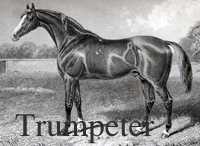
|
Trumpeter ch c 1856 (Orlando
- Cavatina, by Redshank). Sire Line
Camel.
Family 1-o.
The best of the eight yearlings sold from the Hampton Court stud in
1857, he was purchased by Harry Hill for 290gs. A light chestnut
with three white heels and a bald face he was said to be "full of
quality". In his only start as a two year old he was unplaced at
Bath. The following year he won the 8 furlong Biennial at Newmarket
Craven and the 12 furlong Biennial at Bath, pulling up "very lame"
in the latter. Nevertheless he started 3rd favourite for the Derby
and finished 3rd to Musjid (br c 1856
Newminster) and Marionette (b c 1856
Touchstone). One of his legs gave out altogther and he was taken
out of training. He covered initially at Althorp and later at
Hampton Court. His stock were often said to be "delicate and
difficult to train". Queen's Messenger (b c 1869) was thought "one
of the gamest horses that ever looked through a bridle" and was
noted for the beauty of his "small Arab-like head and ears" and won
the Prince of Wales's Stakes and the St James's Palace Stakes. Salpinctes (b c 1862) won the Cesarewitch. Other sons include Distin
(b c 1864) who was used in the stud, and Plutus (b c 1863), a
stallion in France, who was the grandsire of the St Leger winner
Rayon d'Or (ch c 1876 Flageolet) who in turn was the grandsire of
the Two Thousand Guineas winner Norman (b c 1905 Octagon). His best
known daughter is perhaps Land's End (ch f 1873) who became the 3rd
dam of the Ascot Gold Cup winner
Cyllene (ch c 1895 Bona Vista).
Basilia (ch f 1866) was the 2nd dam of the highly regarded Prix de
Diane and Prix Royal Oak winner Bavarde (br f 1884
Hermit) who produced the Prix
Royal Oak winner Bombon (ch c 1892 Richelieu). Bijou (ch f 1869) was
the 2nd dam of the Prix du Jockey Club winner Callistrate (br c 1890
Cambyse). May Queen (br f 1863) was the ancestress of the French
stallion Saint Just (ch c 1907 St. Frusquin) and a large family of
winners and Quick Stream (ch f 1873) the ancestress of an extensive
and successful branch of
Family 19-b. |
|
|
|
|
CHATTANOOGA (GB) |
|
|
|
|
|
|
|
|
Chattanooga ch c 1862
(Orlando - Ayacanora, by
Birdcatcher). Sire Line Camel.
Family 3-n.
His dam Ayacanora (ch f 1854) won the Ham Stakes at Goodwood, the
Hopeful Stakes and the Column Stakes and finished 3rd to Imperieuse
(b f 1854 Orlando) for the One Thousand Guineas Stakes. The Royal
Stud acquired her and her foal Cachuca (b f 1860
Voltigeur) from Lord Portsmouth in
1861. She also produced the July Stakes winner Sir Amyas (ch c 1869
Orlando). Chattanooga was beset by problems with his wind, probably
inherited from his grandam
Pocahontas (b f 1837 Glencoe),
and ran only as a two year old when he won the Criterion Stakes. In
the stud he got Printanniere (bl f 1872), the dam of the Rous
Memorial Stakes and Lincolnshire Handicap winner Poulet (ch c 1877
Peut-Etre), and Wellingtonia (ch c 1869) who became a very
successful stallion in France. Chattanooga himself was leased for
the stud to France in 1878 and exported there in 1885. |
|
|
|
|
TEDDINGTON (GB) |
|
|
|
|
|
|
|
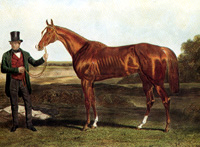
|
Teddington ch c 1848 (Orlando - Miss
Twickenham, by Rockingham). Sire Line
Camel.
Family 2-t.
Bred by Jack Tomlinson he was campaigned by Sir Joseph Henry Hawley
(1814-1875), 3rd Bt, Leybourne, Kent, who also raced the Derby
winners Beadsman (br c 1855 Weatherbit), Musjid (br c 1856
Newminster) and Blue Gown (b c 1865
Beadsman) along with the Two Thousand Guineas winner Fitz-Roland (ch
c 1855 Orlando) and the St. Leger winner
Pero Gomez (b c 1866 Beadsman). He was described as a small
short horse "low in withers, straight in shoulders, short and
upright in pasterns, small-footed" and "calf-kneed" although his
head and neck were "especially game and bloodlike". His speed,
bottom and weight carrying ability were attibuted to his "high
muscular loins and fine slashing action". In 1850 he won the £920
Chesterfield Stakes at Newmarket in July beating Ariosto (ch g 1848
Orlando) and the £350 Molecomb Stakes at Goodwood beating Hippolytus
(b c Emilius). In 1851 he won a
£700 sweep at Newmarket Craven beating Midas (ch c Beiram). He next
won the Derby at Epsom beating Marlborough Buck (b c 1848
Venison) by 2 lengths, the
Northumberland Plate winner Neasham (br c 1848 Hetman Platoff), the
Two Thousand Guineas winner Hernandez (br c 1848
Pantaloon) and 29 others,
including Newminster (b c 1848
Touchstone), Mountain Deer (b c 1848
Touchstone) and the Doncaster Cup
winner Hungerford (ch c 1848 John o'Gaunt). Although he had a sore
leg before the Derby and would only "pick the split peas out of his
corn" his jockey noted that he only had to spur him once and he
"came with such a vengeance as almost to run over Ariosto". He also
walked over for the Don Stakes and won a 1000 sovs match at
Newmarket Second October from Mountain Deer. In 1852 he walked over
for 200 sovs at Goodwood, won the £280 Cup at Warwick beating Little
Harry (b c 1849 Epirus) by a head and the Cup at Doncaster, beating
the Goodwood Cup winner Kingston (b c 1849
Venison) by a neck. In 1853 he
won the 500 sovs Emperor of Russia's Plate (Ascot Gold Cup) beating
Stockwell (ch c 1849
The Baron). In the stud his
sons were generally unremarkable, however, several of his daughters
achieved considerable distinction. Marigold (ch f 1860) won the
Stewards' Cup and produced the Derby winner and Ascot Gold Cup
winner Doncaster (ch c 1870
Stockwell). William Stirling
Crawfurd's Mayonaise (b f 1856) won the One Thousand Guineas Stakes
and is the taproot mare of
Family 3-l while another daughter Tight-Fit (b f 1856) is the
the taproot mare of Family
13-d. Teddington was sent to Austria-Hungary about 1862. |
|
|
|
|
FITZ-ROLAND (GB) |
|
|
|
|
|
|

|
Fitz-Roland ch c 1855
(Orlando - Stamp, by Emilius).
Sire Line Camel.
Family 1-b.
Bred by HM Queen Victoria he was a full brother to the Ascot Stakes
winner Redemption (ch f 1852). The highest priced yearling in the
Hampton Court sale of 1856 he was purchased and raced by Sir Joseph
Hawley, the owner of Teddington (above). He finished 6th in the
Woodcote Stakes in his only appearance as a two year old. At three
he won the Two Thousand Guineas Stakes at Newmarket, beating The
Happy Land (br c 1855 Jericho) by a length and a half. Many thought
The Happy Land deserved the win. An anonymous letter to Lord
Ribblesdale, the owner of The Happy Land, had said that Fordham, his
jockey, intended to prevent the horse from winning and the letter so
upset Fordham that he sent The Happy Land along the entire way at
such a pace that the field was left behind and Fitz-Roland only
caught him towards the end. He went unplaced in Beadsman's Derby but
won the St James's Palace Stakes and the Stockbridge Derby, both
over 8 furlongs. He didn't race again until he was five when he went
unplaced to Baron de Rothschild's Queen of the Vale (b f 1858 King
Tom) for the Queen's Stand Stakes at Ascot. He covered briefly at
Hampton Court before being sent north. His stud career was
relatively unremarkable. His son Paladin (ch c 1870) had some
success in the stud in France getting the Prix Jean Prat winner
Amazon (ch c 1886) and later the Priz Rieki Wolgi winner Etna (ch f
1890) in Russia. His daughter Miss Roland (b f 1863) produced the
St Leger and Doncaster Cup winner Craig Millar (ch c 1872 Blair
Athol). Another daughter Genuine (br f 1869) was the 3rd dam of the
Two Thousand Guineas winner Sweeper (ch c 1909 Broomstick) and
ancestress of many other winners in
Family 8-f. |
|
|
|
|
DIOPHANTUS (GB) |
|
|
|
|
|
|
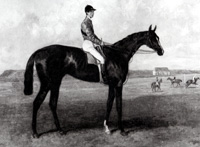
|
Diophantus ch c 1858 (Orlando
- Equation, by Emilius). Sire
Line Camel.
Family 7-a.
Bred by HM Queen Victoria and raced by George Harry Grey (1827-1883), 7th Earl
of Stamford and 3rd Earl of Warrington, Dunham Massey, Cheshire. He
was a half brother to the Gimcrack Stakes winner Exact (ch f 1850
Birdcatcher). In 1860 he
won the £465 Ascot Biennial by 4 lengths beating Lupus (b c 1858
Loup-Garou), the £365 Mottisfont Stakes by half a length at
Stockbridge beating Russley (b c 1858 Oulston), went unplaced for
the Chesterfield Stakes at Newmarket in July won by Touch-Me-Not (b
f Touchstone), won the £600 Molecomb
Stakes by a length at Goodwood beating Parasite (ch c
Rataplan) and finished 4th for
the Prendergast Stakes at Newmarket Second October won by
Preceptress (ch f 1858 Chatham). In 1861 he won the £3330 Two
Thousand Guineas Stakes "very easily" by 3 lengths at Newmarket
First Spring, beating Kettledrum (ch c 1858
Rataplan), Klarikoff (b c 1858
De Clare), Knight of St. Patrick (b c 1858
Knight of St. George)
and 12 others. He then finished 3rd for the Derby at Epsom won by
Kettledrum, finished 3rd for the £465 Ascot Biennial won by Lupus,
won the £225 Midsummer Stakes "in a canter" by 3 lengths at
Newmarket in July beating Russley and walked over for 300 sovs at
Goodwood. |
|
|
|
|
CHEVALIER
D'INDUSTRIE (GB) |
|
|
|
|
|
|
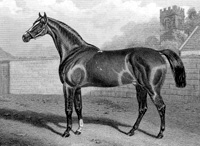
|
Chevalier D'Industrie ch c
1854 (Orlando - Industry, by Priam). Sire Line
Camel.
Family 2-f.
Bred by Charles F Greville his dam (br f 1835) won the Oaks Stakes
and produced the Coronation Stakes winners Stitch (b f 1842
Hornsea), Distaffina (b f 1845 Don
John) and Barcelona (br f 1848
Don John). She was thought "pretty to the eye, and possessed of
considerable spirit," although she "was of an uncommonly nervous
temperment." Standing over 16 hands Chevalier D'Industrie was said
to have a neat head well set on to a good strong neck with excellent
shoulders, a "capital barrel," and a "rare good back". His strong
legs were pronounced "decidedly short," although apparently no
detraction to his grand carriage. His temperment was notably good.
He was sold as a yearling for 255gs in Mr Greville's sale to Mr Padwick
and trained by Mr Goater at Findon. In 1856 he won a £355
sweep at Northampton, beating Lord Anglesey's Tricolor (b f 1854
Touchstone), finished 2nd for the
£670 Chesterfield Stakes at Newmarket in July after running a dead
heat with Lord Glasgow's roan Hernandez filly and then losing the
run off, finished 2nd for the £296 Bentinck Memorial at Goodwood won
by Mr I'Anson's Blink Bonny (b f 1854
Melbourne), went unplaced for
the £415 Eglinton Stakes at Doncaster and finished 3rd for the £390
Triennial at Newmarket First October. In 1857 he was unplaced for
Blink Bonny's Derby at Epsom, finished 2nd for the Cup at the same
meeting, finished 3rd for the £450 Ascot Derby, was unplaced for the
Cup at the same place won by Skirmisher (br c 1854
Voltigeur), won the £1000 Gratwicke
Stakes at Goodwood beating Zuyder Zee (b c 1854 Orlando), finished
2nd for £296 Bentinck Memorial Stakes at the same meeting won by
Blink Bonny by 20 lengths, walked over for the Cup at Brighton and
finished 3rd for the 300 sovs Royal Plate at Hereford won by the
Ascot Gold Cup winner Fisherman (br c 1853 Heron). He covered at Mr Theobald's Stockwell Stud in 1859, at Mr Mitchell's from 1860 to
1862, then moved to the Painter stud near Stafford until 1866 and
was subsequently sold for 500gs to Mr Gulliver. His best son was Friponnier (ch c 1864) although he is probably better known as the sire of the 2nd dam of the triple crown
winner Isinglass (b c
1890 Isonomy). |
|
|
|
 |
|
|
|
|

